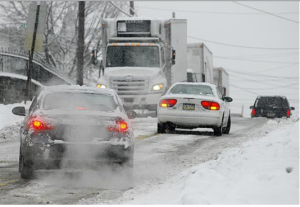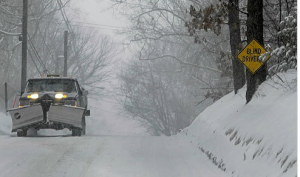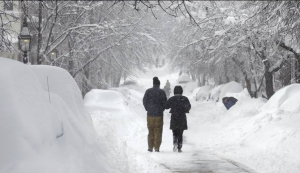Snow Heads Out to Sea
 UPI: A massive storm headed out to sea Saturday after dumping up to 3 feet of snow in parts of Canada, New England and New York and claiming at least six lives.
UPI: A massive storm headed out to sea Saturday after dumping up to 3 feet of snow in parts of Canada, New England and New York and claiming at least six lives.
The storm, formed by the collision of two weather systems, was slightly less severe than predicted, CNN reported. Forecasters said before the snow began falling the blizzard might be a record-breaker in the Boston area.
The storm left about 650,000 homes and businesses without power. In Massachusetts, part of Hull, 20 miles southeast of Boston, was evacuated because of coastal flooding.
At least four deaths in New York, Connecticut and southern Ontario were blamed on the storm. A 12-year-old Boston boy died of carbon monoxide poisoning and a 49-year-old Connecticut man collapsed and died shoveling snow.
By Saturday afternoon, flights were starting to take off at New York area airports. Massachusetts Gov. Deval Patrick lifted a statewide ban on driving at 4 p.m., 24 hours after it took effect.
Logan International Airport in Boston and Bradley International Airport in Windsor Locks, Conn., were still shut down Saturday but limited service has resumed at New York-area airports, CNN said. About 5,000 flights at about 60 airports were canceled Friday due to the storm.
Amtrak said it has canceled all Saturday service between New York and Boston, as well as its Springfield Shuttle service from New Haven, Conn., to Springfield, Mass.
Amtrak crews worked through the night to clear track of snow and downed trees, and make necessary track repairs.
Trains were running Saturday between New York and Washington, and the Empire Service between New York and Albany and Keystone Service between New York, Philadelphia and Harrisburg was also operating.
Major highways were all but abandoned as dozens of cars remained immobile on the Long Island Expressway after being trapped by heavy snowfall late Friday.
Parts of Connecticut had as much as 38 inches of snow by Saturday morning. Worcester, Mass., had 27 inches and Boston had 21 inches.
In New York City, which received a relatively paltry 8 inches in Central Park, Mayor Michael Bloomberg told people to stay home and warned against the panic buying of gasoline.
 The hundreds of thousands of people without electricity probably won’t have their power restored until after the storm ends, when utility workers will be able to dig out the lines from under mounds of snow, said Marcy Reed, president of National Grid.
The hundreds of thousands of people without electricity probably won’t have their power restored until after the storm ends, when utility workers will be able to dig out the lines from under mounds of snow, said Marcy Reed, president of National Grid.
Some of those power lines had been brought down by high winds, The Boston Globe reported. Logan International Airport reported a peak gust of 76 mph, the equivalent of a Category 1 hurricane, National Weather Meteorologist Alan Dunham said.
The wind is also whipping high waves. Dunham said a coastal flood warning had been issued in Massachusetts for Cape Cod and the east-facing coast.
More than 404,000 power outages have reported in the state.
Nearly 30 percent of the National Grid customers in Rhode Island were without power, the Providence Journal reported. Heaviest hit were the towns of Barrington and Bristol, where everyone was without power, and Warren, where only 1 percent of residents had electricity.
 Meteorologists said the storm was so intense because two storms had combined into one, The (Newark, N.J.) Star-Ledger reported.
Meteorologists said the storm was so intense because two storms had combined into one, The (Newark, N.J.) Star-Ledger reported.
“It’s not that this storm is so unbelievably intense from a pressure standpoint — it’s just sopping wet,” said Andrew Freedman, a senior writer at Climate Central. “The moisture content of this storm and the amount of liquid it’s going to produce is amazing.”
Category: General Update, News










